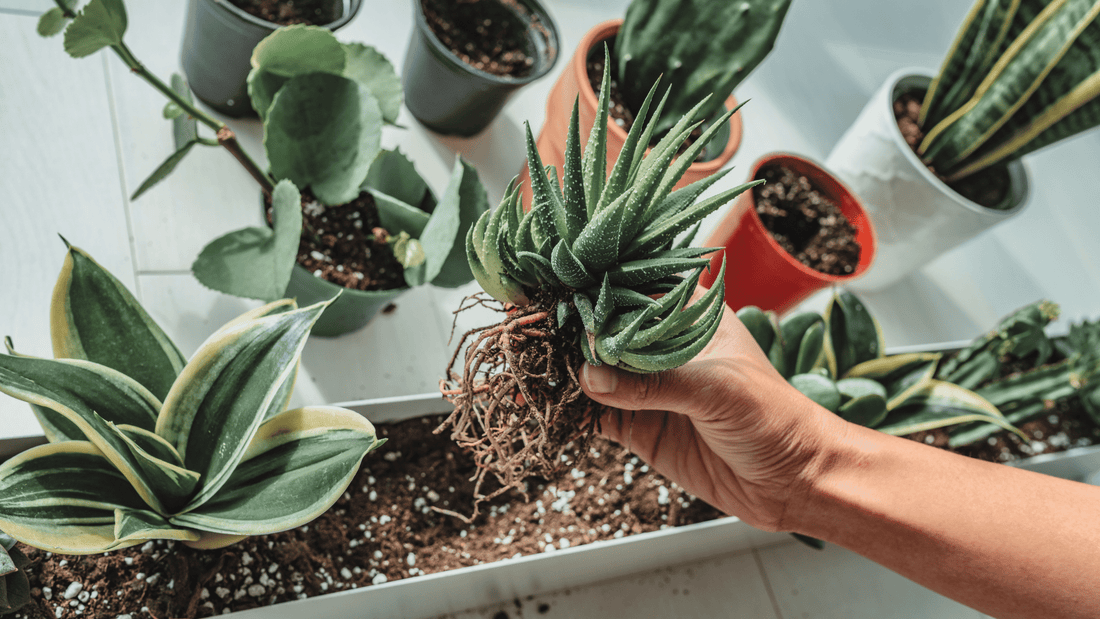
How to Reduce Transplant Shock
**This post contains affiliate links. We may be paid a portion of any sales made via these links.
Water propagation has heaps of benefits – it’s simple, beginner-friendly causes minimal stress, makes virtually no mess, means fewer pests, and promises root growth beyond your wildest dreams (more on that here). But, just like transferring or repotting to a bigger pot full of soil, transplanting a plant to water can cause dreaded plant transplant shock. Transplant shock symptoms include failure to root, brown, yellow, or wilting leaves that are highly delicate and easily fall off when touched.
The thing is, plants get comfortable in their environments. And movement isn’t particularly welcomed by them – even if it’s desperately needed to provide more nutrients or to give them more room to grow. For one, plants expect that their home is the only home they’ll ever have. In the wild, plants don’t just up and move – they grow until there’s physically no more room.
When we move plants from one location to another, they’re forced to readjust to a new environment. And, just as it would if we moved from one house to another, this can take time, care, and attention. In a sense, plants are a lot like children. They need a lot of TLC to help guide them through the transition and flourish in their new environment. With the right attention, your plants can not only survive the transplant but actively thrive in their new water environment.
What is plant transplant shock?
Transplant shock occurs when moving a plant from one environment to another. This includes repotting the plant into a bigger pot to give it more room to grow and more nutrients to thrive. It also includes transferring a soil-based plant into a new water-based environment.
A plant suffers from transplant shock when the root can’t adapt to the new environment. This prevents it from taking in the nutrients it needs, causing it to be weak and fragile for a length of time that can last from just two weeks to up to five years! As you can imagine, in the worst-case scenario, plants suffering from transplant shock can wither and die.
Minimizing plant transplant shock
While we can’t always completely prevent hydroponic transplant shock (when transferring a plant from soil to water), we can minimize the effect to equip the plant with the best possible chance of survival. This includes:
Minimizing root damage
When transplanting, be careful and delicate with the roots. Gently loosen the soil around the roots and be careful not to break them. The more roots you can keep, the stronger the plant will be to survive the transplant. Plus, the tiny roots at the farthest end of the root ball are vital to the plant’s health and growth, so be particularly careful with these.
Keeping hydrated
A plant suffering from transplant shock needs plenty of water to stay hydrated and nourished in its new water environment. Once you’ve put your cutting into your propagation vase of choice, you’ll want to change the water every 2-5 days for optimal health. Icky, slimy water can kill your cutting, so be sure to keep an eye out!
Caring for a plant with hydroponic transplant shock
If you’ve followed all of the steps above and your plant is still struggling to manage the stress of the transplant, there’s only one thing left to do: give your plant the TLC it truly needs and deserves.
No movement
Now that your plant is in water, make this it's home for the foreseeable future. Don’t worry, this doesn’t have to be forever (unless you want it to be!), just until it’s had sufficient time to adapt and recover from the shock. Just like humans, plants can take some time to adjust to new environments and develop new bearings. By keeping the plant as it is, you’ll prevent any further damage or another transplant shock to the roots.
Trimming the plant
Getting rid of excess leaves – especially ones that are dying – is a crucial part of the process to aid a plant suffering from transplant shock. The fewer leaves a root has to care for, the more energy it has to distribute to the happy, healthy leaves. Plus, the fewer leaves, the more energy can be diverted into repairing the roots.
Keeping it fed
Like a soil-based plant, your water propagations need both sunlight and nutrients to help it grow. While water contains a ton of nutrients and minerals (think magnesium, calcium, chloride), this is not always enough for some plants. Water-soluble fertilizers can work wonders for water propagations and should be added each time the water is changed to help give the roots the energy it needs to revive your cutting and thereby minimize hydroponic transplant shock.
An overview
No matter how careful you are, it’s impossible to avoid all transplant stress altogether. Just as we, as humans, grow accustomed to our homes and towns, plants grow used to their little pots filled with soil (check out my favorite nursery pots). Transferring to a new, water-based environment can cause a significant shock to the system as the plant adjusts to its new environment – this is totally normal!
By minimizing root damage, keeping hydrated, preventing further movement, and trimming the plant, you can keep your plants in optimal health so they can survive transplant shock and thrive in their new water homes!
Create the perfect little station for your transplanted cuttings!
What's Next?
Exercise your patience propagating this favorite, slow-growing plant
Access the key to successful plant propagation (hint: it's not complicated)
Check out our featured propagation vases
